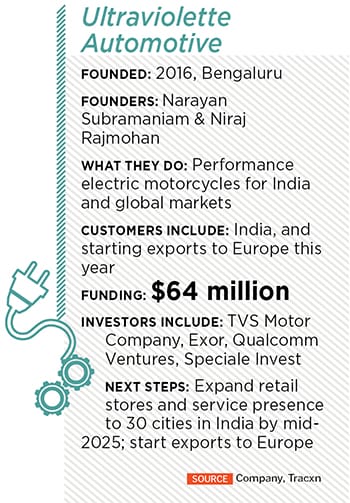Ultraviolette: Building a performance EV bike in India for the world
The Indian market is well on its way to embracing electric two-wheelers and Ultraviolette—with its new motorcycle and design inspired by aerospace—is optimistic about their increased adoption
 Niraj Rajmohan (left), co-founder and CTO, and Narayan Subramaniam, co-founder and CEO of Ultraviolette
Image: Selvaprakash Lakshmanan for Forbes India
Niraj Rajmohan (left), co-founder and CTO, and Narayan Subramaniam, co-founder and CEO of Ultraviolette
Image: Selvaprakash Lakshmanan for Forbes India
This year, Narayan Subramaniam and Niraj Rajmohan and team Ultraviolette released the next iteration of their F77 electric performance motorcycle—the F77 Mach 2. With it, they announced three levels of traction control, and 10 levels of regenerative braking, a function that’s important to extracting more range from electric vehicles (EV).
The bike offers 40.2 horsepower, 100NM of torque, top speed of 155 kmph and a maximum of 323 km per charge. As with its predecessor, for the top specs, buyers need to choose the ‘Recon’ variant. The bikes are offered in two shades each of red and grey, one yellow, white, silver, a blue and a black.
“One of our fundamental innovations is the amount of energy we are able to recover through our systems,” Subramaniam tells Forbes India. “We are able to recover between 25 percent and 30 percent of the expended energy through regenerative itself.” In comparison, electric scooters today can recover 5 to 8 percent, he says.
Another new feature is a system called Dynamic Stability Control, which Subramaniam says is a world first “on any two-wheeler”. He explains it like this: When one slows down, braking can be mild, active or in panic. In the last case, the ABS (anti brake-locking system) wants to prevent locking of the wheels, while the regenerative system tries to actively slow down the vehicle.
Ultraviolette has developed a system that figures this out in real time and accords the correct hierarchy between the ABS and the regenerative function. “This hadn’t been done at all on any two-wheeler. We had to develop it for the first time,” he says.
(This story appears in the 01 November, 2024 issue of Forbes India. To visit our Archives, click here.)




 Subramaniam and Rajmohan started Ultraviolette Automotive in 2016, inspired by aerospace in the way they approached their design, they always like to say. Today they’re naming their showrooms ‘Space Stations’. They’ve expanded beyond Bengaluru, where the company is headquartered. They are now present in Pune, Ahmedabad, Hyderabad, Cochin, Vizag, and recently Nepal as well. By mid-next year, they expect to be in 30 cities in India. They’re also about to start exporting CBUs (completely built units) to Europe.
Subramaniam and Rajmohan started Ultraviolette Automotive in 2016, inspired by aerospace in the way they approached their design, they always like to say. Today they’re naming their showrooms ‘Space Stations’. They’ve expanded beyond Bengaluru, where the company is headquartered. They are now present in Pune, Ahmedabad, Hyderabad, Cochin, Vizag, and recently Nepal as well. By mid-next year, they expect to be in 30 cities in India. They’re also about to start exporting CBUs (completely built units) to Europe.













